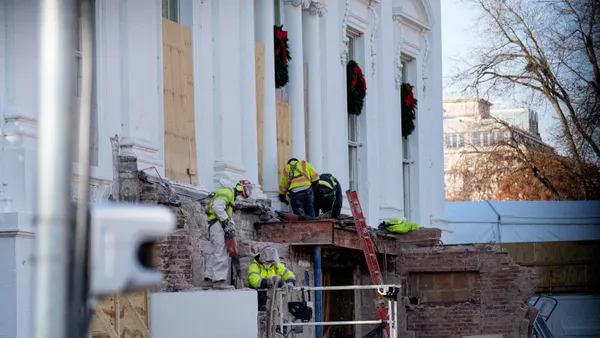Dive Brief:
- Michigan OSHA has published its interim enforcement plan, which the agency will use to investigate COVID-19 related hazards and illnesses. The plan will be used by agency officials in their enforcement of emergency novel coronavirus workplace rules that went into effect in October and will remain in force until at least April.
- Industrial hygienists from MIOSHA's Construction Safety and Health Division (CSHD) will respond to potential violations at construction jobsites, although most complaints and referrals involving a low or medium risk to exposure to the coronavirus will be handled by telephone and letter. When the agency responds to non-COVID-19 issues, hygienists will be able to expand the scope of the investigation to include any COVID-19 violations they observe. Hygienists are also authorized to initiate a companion investigation if they observe more than one or two violations related to COVID-19.
- MIOSHA has taken this action because 30 workers in the state have died from COVID-19 since March and another 127 have been hospitalized because of workplace exposure to the coronavirus. The agency has received more than 3,800 complaints from employees about employers they believe are not providing adequate protection from the novel coronavirus.
Dive Insight:
Michigan was the second state to implement emergency rules in response to the pandemic, preceded by Virginia. Earlier this month, Oregon became the third state to provide emergency guidance when its OSHA updated its temporary rule addressing COVID-19 workplace risks. Guidance for construction industry employers in the state includes:
- Screening of employees and visitors to the site.
- Physical distancing measures.
- Reorganization of workflow when possible (encouraged but not mandated).
- The use of masks, face coverings and face shields when physical distance cannot be maintained.
The agency does not require construction workers to wear a face mask when wearing a face shield but encourages it.
Michigan, Oregon and Virginia have instituted their own COVID-19-related emergency standards and plans in the absence of a national standard from federal OSHA. The AFL-CIO took OSHA to court in an attempt to force the safety agency to create a national emergency standard in the wake of the pandemic, but a federal judge threw out the case.
OSHA and opponents of the rule maintained that the information around the novel coronavirus has been fluid and that it would be difficult to write a rule given those constant changes. Experts have told Construction Dive in the past that lack of a federal standard does not prevent OSHA from citing employers under the General Duty Clause, Section 5(a)(1) of the Occupational Safety and Health Act, which requires employers to maintain a workplace free of recognized hazards.
This month, however, OSHA issued guidance on the most frequently cited of its standards when it comes to COVID-19 violations. In addition to the General Duty Clause, they are:
- Respiratory protection (1910.134).
- Recording and Reporting Occupational Injuries and Illnesses (Subpart 1904).
- Personal Protective Equipment (1910.132).
The most-violated standard was 1910.134(e)(1), which is a failure on the part of the employer to provide a medical evaluation before a worker was fit-tested or used a respirator. That was followed by other violations related to medical evaluations and fit testing for respirators.












